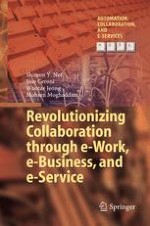2015 | OriginalPaper | Buchkapitel
e-Logistics, e-Production, and e-Supply Networks
verfasst von : Shimon Y. Nof, Jose Ceroni, Wootae Jeong, Mohsen Moghaddam
Erschienen in: Revolutionizing Collaboration through e-Work, e-Business, and e-Service
Verlag: Springer Berlin Heidelberg
Aktivieren Sie unsere intelligente Suche, um passende Fachinhalte oder Patente zu finden.
Wählen Sie Textabschnitte aus um mit Künstlicher Intelligenz passenden Patente zu finden. powered by
Markieren Sie Textabschnitte, um KI-gestützt weitere passende Inhalte zu finden. powered by
Logistics is the organization and control of the flow of goods, information, and other resources in a cycle between the points of origin and consumption to meet specific requirements of different entities of a production, manufacturing, supply, or service network, e.g., customers or corporations. Logistics is a primary channel of any supply process that adds the value of time and place utility. Logistics involves the integration of information, transportation, inventory, warehousing, material handling, packaging, and occasionally security. Today, the complexity of production logistics can be modeled, analyzed, visualized, and optimized by plant simulation software. Various research areas and applications of logistics can be found in many references. However, this chapter focuses on material handling, especially in automated material handling, as a set of practical and important problems in the areas of production, manufacturing, and logistics ranging from the physical movement of products to storage and warehousing, and control and protection of products during various processes such as packaging, distribution, disposal, and so forth.
Modern production and manufacturing processes are increasingly exceeding boundaries of single sites, occurring within networks of geographically distributed plants and multiple levels of suppliers (as discussed in Chapter 6). The emerging concepts and paradigms of extended enterprise, as networks of collaborative selforganizing manufacturing enterprises, are becoming a prevailing solution to this transformation. In line with this evolution, a remarkable part of logistics processes are now taking place out of the boundaries of single enterprises and between several networked production and manufacturing sites. Extended enterprises enable the creation of architectures, models, and methodologies to integrate B2B and B2C processes beyond the boundaries of enterprises. The second half of this chapter is then devoted to the basic and emerging concepts in the design, planning, and control of distributed production and supply networks.
